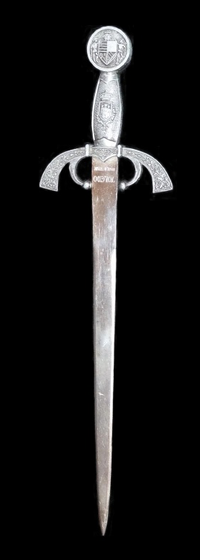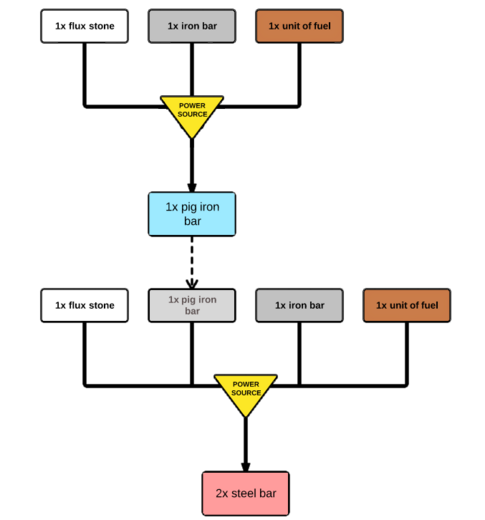- v50 information can now be added to pages in the main namespace. v0.47 information can still be found in the DF2014 namespace. See here for more details on the new versioning policy.
- Use this page to report any issues related to the migration.
Difference between revisions of "v0.34:Steel"
(→Bugs) |
|||
| Line 70: | Line 70: | ||
==Bugs== | ==Bugs== | ||
| − | Having a | + | Having a smelter/magma smelter inside a burrow can prevent the creation of steel and certain other alloys. |
{{gamedata}} | {{gamedata}} | ||
{{metals}} | {{metals}} | ||
Revision as of 20:52, 11 June 2013
| |||||||||||||||||||||||||||||||||||||||||||||||||||||||||
| Uses | |||||||||||||||||||||||||||||||||||||||||||||||||||||||||
|---|---|---|---|---|---|---|---|---|---|---|---|---|---|---|---|---|---|---|---|---|---|---|---|---|---|---|---|---|---|---|---|---|---|---|---|---|---|---|---|---|---|---|---|---|---|---|---|---|---|---|---|---|---|---|---|---|---|
| Graphic | |||||||||||||||||||||||||||||||||||||||||||||||||||||||||
|
No graphic. | |||||||||||||||||||||||||||||||||||||||||||||||||||||||||
| Recipe | |||||||||||||||||||||||||||||||||||||||||||||||||||||||||
| Properties | |||||||||||||||||||||||||||||||||||||||||||||||||||||||||
| This article is about an older version of DF. |
Steel is the best common metal for smithing most weapons and armor. Products made with steel also have a very high value, equal to that of gold.
Steel can be created at a smelter by a dwarf with the furnace operator labor activated.
Sedimentary Layers
To smelt steel, you will need iron ore, flux stone, and fuel. Flux is used to remove carbon during the smelting process, while fuel (coke or charcoal) puts it back in. The end result is steel: iron with just the right amount of carbon in it. The three ores of iron (hematite, magnetite, and limonite) can only be found in sedimentary layers, with the exception of hematite, which can occasionally be found in igneous extrusive layers. Furthermore, four of the five flux stones (calcite, chalk, dolomite, and limestone) are found only in sedimentary layers, as well as both coal ores (bituminous coal and lignite) for making coke fuel.
If you have no sedimentary layers at your fortress site, your only hope to make steel is with:
- hematite from igneous extrusive layers
- melting iron items brought by siegers and trade caravans
- marble from metamorphic layers
- wood for making charcoal fuel
(Even if you find and use magma for your furnaces, you'll still need fuel as a reactant in the smelting process, so you'll be cutting down a tree and burning it to make charcoal for every bar of steel you manage to create.)
Recipe
Steel production is fairly complex compared to the creation of other alloys. Important note: in steelmaking, coke or charcoal is also used as an ingredient, apart from its use as fuel. A conventional (non-magma) smelter will require an additional unit of fuel in each reaction.
The first step is to create pig iron:
- Produces:
- 1 bar of pig iron
The second step combines the pig iron with plain iron to produce steel:
- 1 bar of iron
- 1 bar of pig iron
- 1 flux stone
- 1 unit of fuel (as a source of carbon)
- 1 unit of fuel, or magma (to heat the forge)
- Produces:
- 2 bars of steel
The overall reaction consumes 2 bars of iron, 2 units of flux, and 2 units of fuel as ingredients (plus an extra 2 fuel at a conventional smelter for heating). This produces 2 bars of steel.
Remember that smelting iron ore also requires 1 unit of fuel at a conventional smelter, producing 4 bars of iron, which translates to half a unit of additional fuel used in the recipe above (although you will need a full unit up front.)
Bugs
Having a smelter/magma smelter inside a burrow can prevent the creation of steel and certain other alloys.
[INORGANIC:STEEL]
[USE_MATERIAL_TEMPLATE:METAL_TEMPLATE]
[STATE_NAME_ADJ:ALL_SOLID:steel]
[STATE_NAME_ADJ:LIQUID:molten steel]
[STATE_NAME_ADJ:GAS:boiling steel]
[DISPLAY_COLOR:0:7:1]
[BUILD_COLOR:0:7:1]
[MATERIAL_VALUE:30]
[SPEC_HEAT:500]
[MELTING_POINT:12718]
[BOILING_POINT:14968]
[ITEMS_WEAPON][ITEMS_WEAPON_RANGED][ITEMS_AMMO][ITEMS_DIGGER][ITEMS_ARMOR][ITEMS_ANVIL]
[SOLID_DENSITY:7850]
[LIQUID_DENSITY:6980]
[MOLAR_MASS:55845]
[IMPACT_YIELD:1505000]
[IMPACT_FRACTURE:2520000]
[IMPACT_STRAIN_AT_YIELD:940]
[COMPRESSIVE_YIELD:1505000]
[COMPRESSIVE_FRACTURE:2520000]
[COMPRESSIVE_STRAIN_AT_YIELD:940] 160
[TENSILE_YIELD:430000]
[TENSILE_FRACTURE:720000]
[TENSILE_STRAIN_AT_YIELD:225] 200
[TORSION_YIELD:430000]
[TORSION_FRACTURE:720000]
[TORSION_STRAIN_AT_YIELD:215]
[SHEAR_YIELD:430000]
[SHEAR_FRACTURE:720000]
[SHEAR_STRAIN_AT_YIELD:215] no data, used 200
[BENDING_YIELD:430000]
[BENDING_FRACTURE:720000]
[BENDING_STRAIN_AT_YIELD:215]
[MAX_EDGE:10000]
[ITEMS_HARD]
[ITEMS_METAL]
[ITEMS_BARRED]
[ITEMS_SCALED]
[STATE_COLOR:ALL_SOLID:GRAY] |
| Base | |
|---|---|
| Alloys |
Billon • Bismuth bronze • Black bronze • Brass • Bronze • Electrum • Fine pewter • Lay pewter • Nickel silver • Pig iron • Rose gold • Steel • Sterling silver • Trifle pewter |
| Special | |

